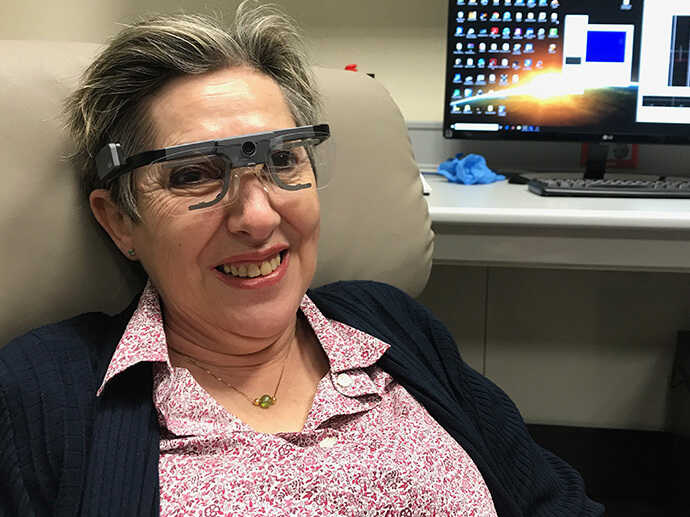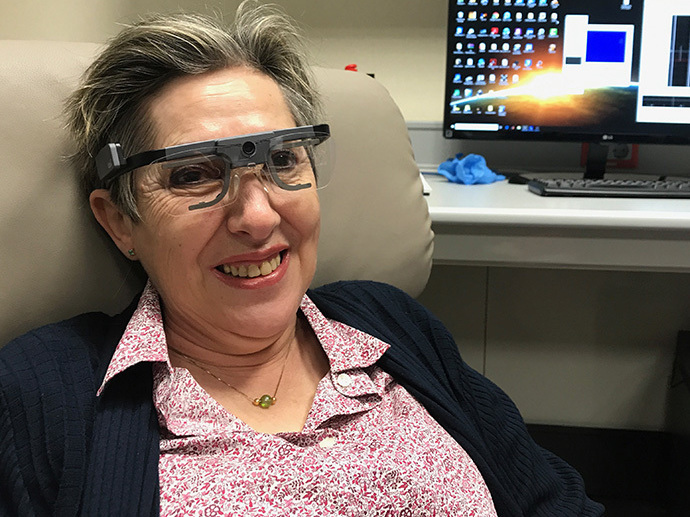Youtubejesusmade a Blind Man See Again

Former science teacher Berna Gómez played a pivotal function in new research on restoring some sight to blind people. She is named every bit a co-author of the study that was published this week. Moran Eye Center, the University of Utah hibernate explanation
toggle caption
Moran Eye Center, the University of Utah

Former scientific discipline instructor Berna Gómez played a pivotal role in new research on restoring some sight to blind people. She is named as a co-author of the study that was published this week.
Moran Eye Center, the University of Utah
A former science teacher who'south been blind for 16 years became able to run into letters, discern objects' edges — and even play a Maggie Simpson video game — thanks to a visual prosthesis that includes a camera and a brain implant, according to American and Spanish researchers who collaborated on the project.
The test subject had the implant for 6 months and experienced no disruptions to her encephalon activity or other health complications, according to an abstruse of the study that was published this week in The Periodical of Clinical Investigation.
The study furthers what it calls a "long-held dream of scientists," to impart a rudimentary form of sight to blind people past sending information directly to the brain'due south visual cortex.
"These results are very heady because they demonstrate both safety and efficacy," said ane of the lead researchers, Eduardo Fernández of Miguel Hernández University, in a argument. "Nosotros take taken a significant step frontward, showing the potential of these types of devices to restore functional vision for people who have lost their vision."
A camera sends visual data directly to the brain
In the experiment, a neurosurgeon implanted a microelectrode assortment into the visual cortex of Berna Gómez, a one-time teacher who has been blind for more than than xvi years. The implant was so paired with a video photographic camera mounted in the eye of a pair of glasses.
Subsequently a training period, Gómez was able to decipher visual data that was fed from the photographic camera straight to her encephalon.
The preparation included a video game that helped Gómez acquire how to interpret the signals coming from the electrodes. In the game, a screen suddenly shows an epitome of Maggie Simpson holding a gun, in either her left or right mitt. The role player must correctly select which mitt holds the weapon; using input from the assortment, Gómez learned how to succeed in that task.
At the time of the written report, Gómez was 57 years old. Because of her participation, including her ability to give clinically precise feedback to the scientists, Gómez was named as a co-author of the study.
Some of the prosthesis' effects were limited; it did non let Gómez identify all letters of the alphabet, for instance. But she "reliably discriminated some letters such as 'I,' 'L,' 'C,' 'V' and 'O,' " according to the written report.
Further studies could use more electrodes to boost visual data
The microelectrode array was implanted through a "minicraniotomy," in a process that the researchers say "is straightforward and follows the standard neurosurgical procedures." It involves making a hole in the skull measuring 1.5-cm (a bit larger than half an inch).
The array is just four mm (most an 8th of an inch) foursquare, but it holds 96 electrodes. The researchers say previous studies accept found around 700 electrodes could give a blind person enough visual information to heave their mobility to a useful extent. And because the implant required only small electrical currents to stimulate the visual cortex, they're hoping to add together more microarrays in the future experiments.
"Ane goal of this research is to give a blind person more than mobility," said Richard Normann, a researcher at the John A. Moran Eye Center at the Academy of Utah. "It could allow them to place a person, doorways, or cars hands. It could increase independence and safety. That'southward what nosotros're working toward."
A clinical trial related to the written report is scheduled to go on through May of 2024. The enquiry is existence funded through several entities, including Espana's Ministry building of Science and Innovation and Miguel Hernández University, too as the Moran Centre Center.
The method of bypassing the eyes altogether could someday restore vision to roughly 148 million people worldwide — that'southward how many people have had the link betwixt their eyes and their brain severed, the researchers say, due to conditions such as glaucoma or optic nervus atrophy.
The arroyo used by the researchers from Utah and Espana is similar to one that was hailed last year, when scientists said they were able to get volunteers to see letters by sending electricity through electrodes on the encephalon's surface.
Visual impairment is one of the most mutual disabilities in the world and scientists are employing several strategies to help people who are affected by it. In another recent success, scientists used the CRISPR gene-editing tool to modify DNA in people to aid them combat a rare genetic eye disease.
johnsontheyeaterve.blogspot.com
Source: https://www.npr.org/2021/10/23/1048699230/scientists-used-a-tiny-brain-implant-to-help-a-blind-teacher-see-letters-again
0 Response to "Youtubejesusmade a Blind Man See Again"
Post a Comment